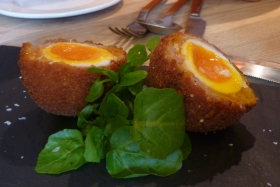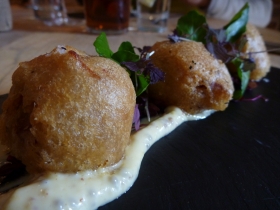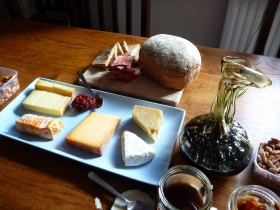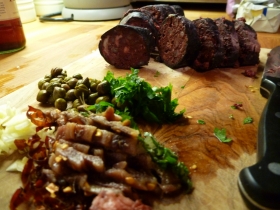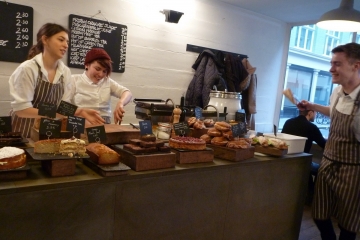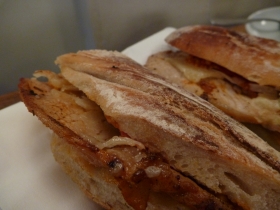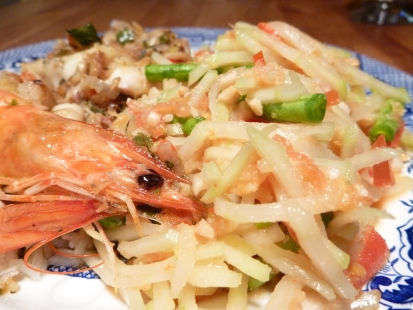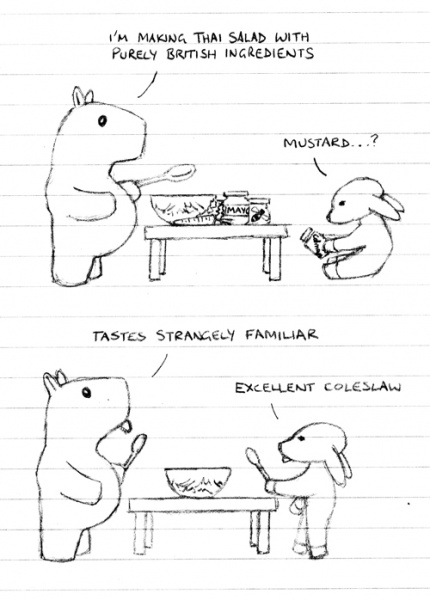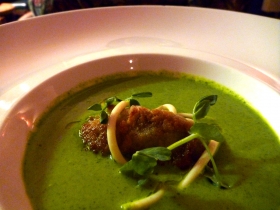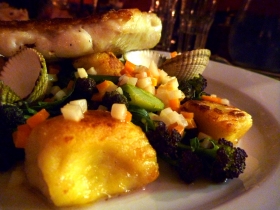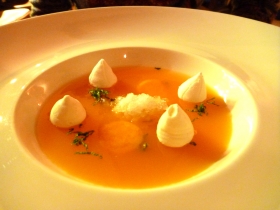We rolled to the New Inn for Sunday lunch in a bit of a funk. Big meal out on Saturday night, rather too much wine, and then the stupid clocks went forward so lunch at 12:30 was going to feel more like 11:30. Given that we didn’t stumble home until midnight on Saturday, groaning like a pack of wolves who have just devoured a whole herd of caribou, we weren’t the most vivacious quartet on what was a truly gorgeous Sunday morning. Bountiful sunlight, thou art offensive to my tender head and squinty eyes! Begone!
Turned out that a leisurely lunch stretching out three courses of excellent cooking over three hours was just about the ticket.
The New Inn is a cheerful place, all the old wood beams scrubbed up to a natural oaken hue with tables and chairs to match. There’s a lot given over to dining, but it remains a proper village pub too with room to swing a pint and outside tables where beer and sun were being soaked up by the locals. We were served by a friendly and helpful band of young ladies, who ignored our occasional vacant stares and blinky gazes.
The food cut through my funk big-time. First up we got a perfect scotch egg: vivid yellow and runny yolk, oinkingly porky sausage meat with a serious punch of lemon and thyme. Moving onto the proper starter, plated on slate, a trio of battered balls of chewy slow-cooked ham hock sat on a swipe of shiny mustard mayonnaise. There was nothing subtle about this dish, a good hit of mustard and the sticky cream of the mayo mashing in the mouth with scrunchy batter and salty ham. Woke me up.
I almost never order chicken, but this morning my head, body and tummy were calling out for something soothing. Although breast, it had been roasted properly to keep juice and flavour intact. Kale and mash were good, as was the jus, but it was the sweetcorn puree that lifted the whole dish. Sweetcorn is so badly underused as an ingredient.
All this is irrelevant, because Maureen’s burger came along and knocked my socks off. Massive. Lamb and beef, absolutely blue in the middle, and laced rather raunchily with blue cheese and truffle. I’ll probably dream about it tonight, and not the kind of dreams I’d ever
tell anyone about. Did I say it was massive? It was huge. Maureen roped off the area and began excavations, but eventually I had to come in and help (oh, hardship). The triple-cooked chips were also maddeningly good.I should note that Tim and Vanessa were also making contented noises about the roast beef and the smoked haddock, and the nibbles I tried were groovy indeed.
It would have been rude not to squeeze in pudding. I squeezed in a lemon posset, which was delicious and always a favourite – rich, tangy and light all at once. Rather niftily served with scrunchy gingernuts and a little slurp of sweet-tart homemade lemonade. Pannacotta was pronounced good, rhubarb ice cream was noted for being good but a little too delicate in the rhubarb flavour.
The New Inn is right at the top end of pub dining for me, from the menu choices to the plating. Everything was delicious and the bill jolly reasonable – £25 each for three hours of relaxed gastronomic entertainment, though admittedly we didn’t have much wine!
‘Cos I’m conscientious I have to say that chef Marcus knew we were coming, on account of the wonders of Twitter.







